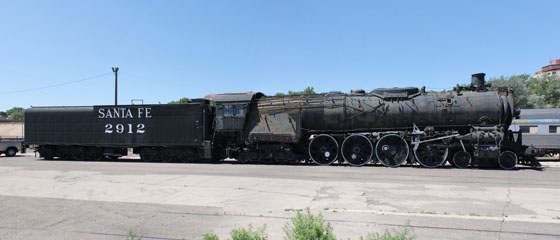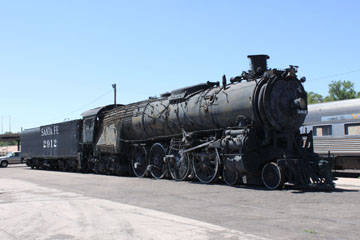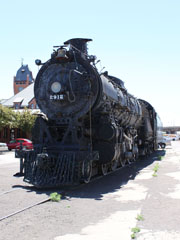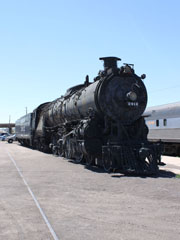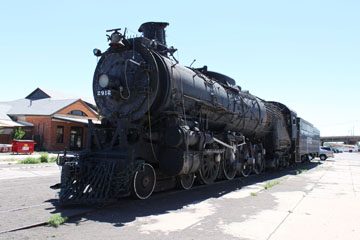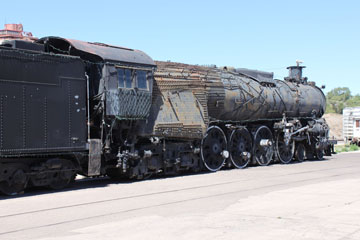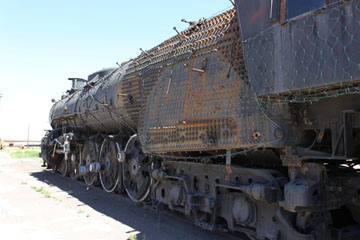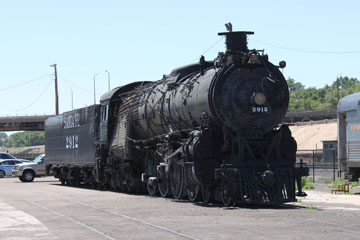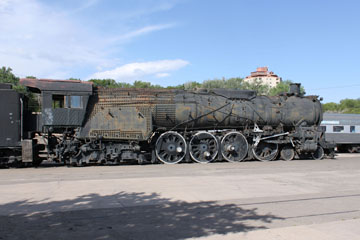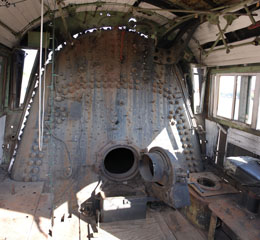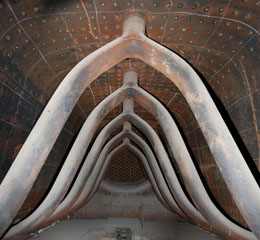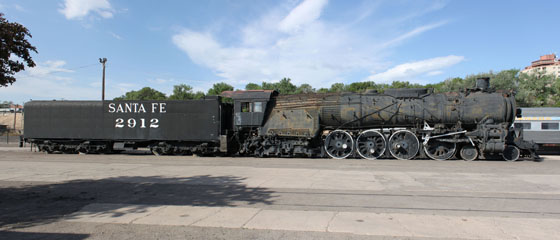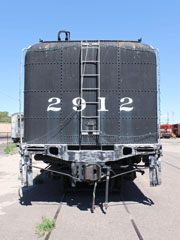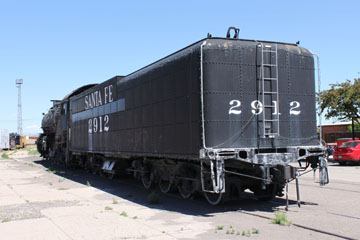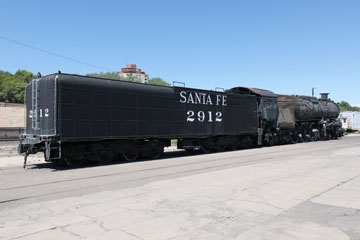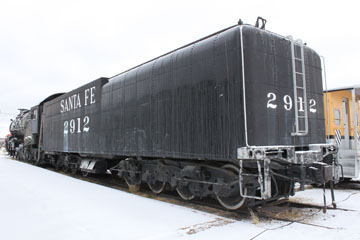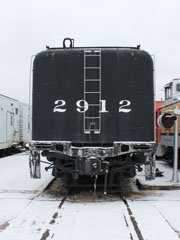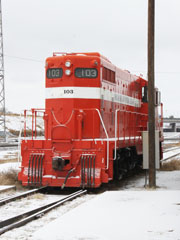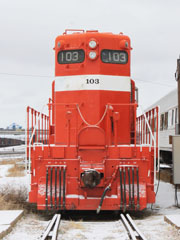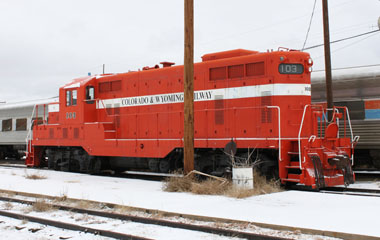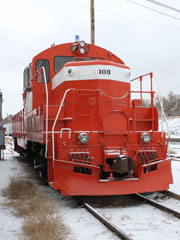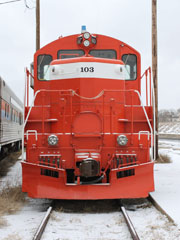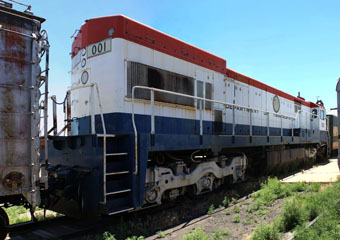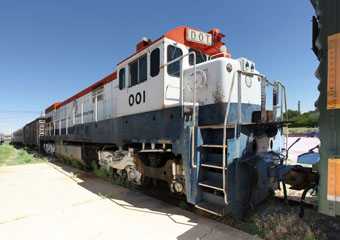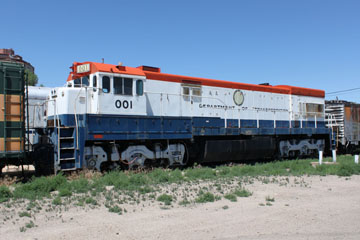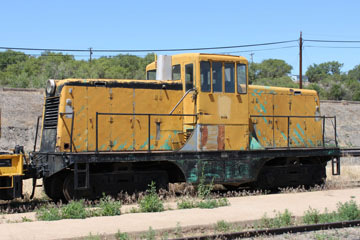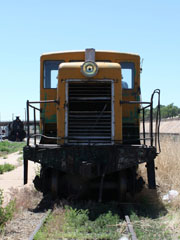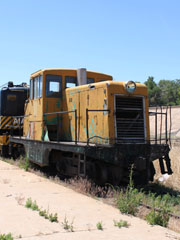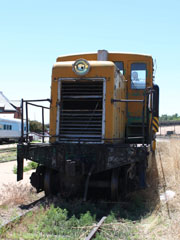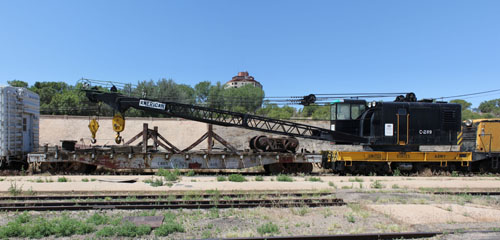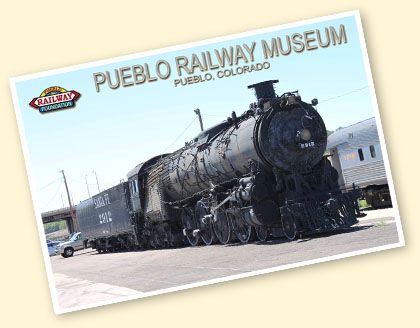

The Pueblo Railway Museum is managed by the all-volunteer, not-for-profit Pueblo Railway Foundation, which was formed in 2003 to continue the activities of the Pueblo Locomotive & Rail Historical Society. The PL&RHS started the collection, but has been disbanded.
The collection is located on W B St next to the old Pueblo Union Depot in the Union Avenue National Historic District of downtown Pueblo, CO. It is about a one hundred mile drive south from Denver on the I-25. The museum seeks to preserve historic railroad equipment and promote interest in railroading, railroad history and the impact of the railroad on the history of Pueblo and the United States.
Pueblo has been a major rail hub since the late 1800s, and the arrival of the railroads contributed to the growth of the city into the largest industrial center west of the Mississippi from 1880 to about 1940. The collection specialises in equipment from railroads that served the city prior to their consolidation into the BNSF and Union Pacific, and includes the only surviving Colorado & Wyoming locomotives and cars.

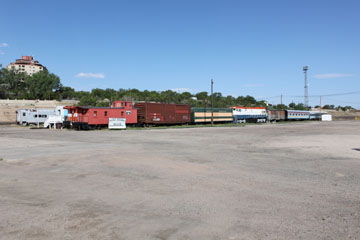
There is no museum building as such. There is a gift shop and information centre inside Colorado & Wyoming Caboose #100, but there are no stated opening hours and, both times I have visited, there has been no-one on site. However, as the collection was unfenced, I was able to get a good look at what was there.
In addition to a few pieces of motive power and an American DiesElectric crane, the equipment includes a number of passenger cars and cabooses. On the right of CW #100 above, is Colorado & Southern Caboose #10538. It was built of wood in 1910 with side doors and no end platforms. In 1920 the side doors were removed and end platforms were installed, and it remained in use until 1968. It is oldest known caboose of this type in original condition in a museum.
Behind #10538 are CW Box Car #93, GN Mail Express Car #2649 with its original "Empire Builder" livery much faded by exposure to the weather, DOT EMD GP7 #001 and BN Reefer Car #935023. This 40' long ice bunker reefer from the first half of the 20th Century was built for the Santa Fe. It was later used as a "buffer car" on long continuous welded rail trains.

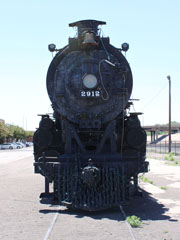
Above, left and right, #2912, an AT&SF Class 2900 Northern (4-8-4) type locomotive, basks on a mid summer day, but is still draped with Xmas lights!
The AT&SF bought sixty-five Northerns from Baldwin from 1927.
#2912 was one of the last thirty (#2900-#2929) delivered in 1944.
Although stripped of much external gear, it still has the sleek lines and crouching front end characteristic of Santa Fe Northerns. The Pueblo Railway Foundation is looking to restore #2912 to its original appearance, but it is beyond bringing back into steam.
An oil burner, the engine weighs 510,150 lbs. It has a 108 sq ft grate and thermic syphons of 30.5 sq ft were fitted to its 479 sq ft firebox, which included 124 sq ft in an 84" long combustion chamber.
With an additional 2,366 sq ft of superheating, #2912 had a total heating surface of 7,678 sq ft. Operating at a boiler pressure of 300 psi, the locomotive delivered 79,968 lbs tractive effort.
The 2900 design was based on AT&SF's 3765 Class Northerns built in 1938, although wartime restrictions meant certain steel alloys were unavailable. As a result, alternative alloys had to be used and these locomotives became the heaviest Northerns ever built in the US, outweighing their nearest rivals by over 2,000 lbs. They were also the largest.
Although designed to haul fast passenger
services, the heavy westbound freight tonnage also resulting from WWII mobilisation, meant the 2900s were initially assigned to replace Mikados on through freight services on the Santa Fe's Pecos Division, working exclusively between Clovis, NM, and Argentine, KS, with maintenance handled at Clovis.
Above and left, although they have now been removed, #2912, like the other 2900s, was originally built with lightweight roller bearing rods. The 2900s also had Walschaert valve gear and 80" Boxpok drivers, except for the fourth axle, which sported a 1938 style Baldwin Disc driver. All the 2900s were later fitted with Timken roller bearing side rods with needle bearings on the valve gear between 1946 and 1948.
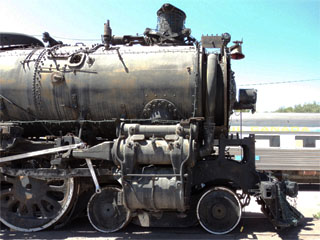
Above, #2912 has 28" x 32" cylinders. With part of the smokebox removed, you can also see the piping of the original Worthington feedwater heater.
The 2900s were amongst the most successful of the Santa Fe's steam locomotives. However, by the end of 1953, all AT&SF operations had been dieselised except for the Argentine-Clovis through freight service, where the last of the railroad's steam engines, including most of the 2900s were in service. The following year, they also did some service on through freights but were entering their last days in operation.
#2912 was one of the last ATSF 4-8-4s shopped at the company's Albuquerque Shops before they were closed in March 1954. The locomotive hauled the last AT&SF steam freight into Clovis from Slaton on the morning of 4th August 1954 and, with its engines in good working order, remained available for peak movements as late as 1958. All the remaining twenty-nine 2900s, including #2912, were finally written from the AT&SF's accounts in April 1959.
Above, #2912's tender weighs 464,700 lbs light and has a 245,000 gallon water and 7,170 gallon oil capacity.
After the war, some 2900s were assigned to passenger service between Kansas City, KS, and Los Angeles, CA, but #2912 stayed in freight service.
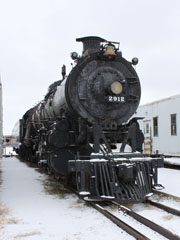
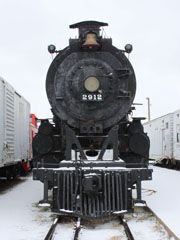
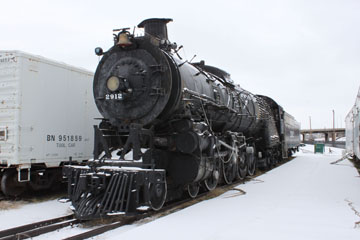
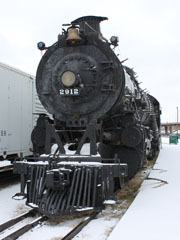
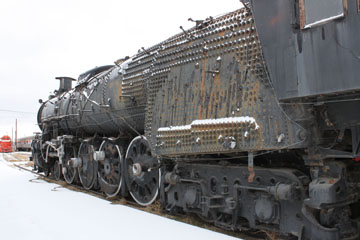
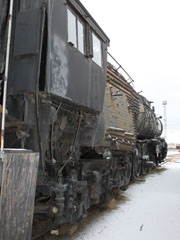
Above, left and right, photos of #2912 taken one winter morning.
You can see another 2900 on the ATSF #2913 page of this website, as well as #2903 on the Illinois Railway Museum Train Shed page. A Sante Fe Class 3751 Northern is also on the ATSF #3759 page.

GP7s could be ordered with either a high or low hood, but #101-#104 were delivered to the C&W with high hoods.
Below and right, however, when the units transferred to the company's steel mill, the front high hood was cut down for better visibility in yard work.
I also got photos of #103 that winter morning (it was not in the yard when I visited in the summer). This is one of four GP7s bought from EMD by the Colorado & Wyoming Railroad in 1951 (#101-#104).
The C&W, a subsidiary of the Oregon Steel Mills, hauls coal, ore and steel on about five miles of track at the Rocky Mountain Steel Mills facility in Pueblo.
#102-#104 were donated to the museum in 2003, and #103 and #104 were repainted in the C&W livery. They have been
well looked after, and are now used by the museum for train rides and switching.


#103 is 55' 11" long and weighs 246,000 lbs. With a 567B 16 cylinder prime mover developing 1,500 hp powering a 600 volt DC generatror to drive four GM-D27B transaction motors, it delivered 40,000 lbs continuous tractive effort at 9.3 mph, with a top speed of 65 mph.
A number of GP7s have survived. You can see others on the Gold Coast Railroad Museum page of this website, the B&O Railroad Museum Yard & Car Shop, Crewe Railroad Museum, Illinois Railway Museum Train Shed and Virginia Museum of Transportation pages.

Weighing 363,00 lbs and 67' 3" long, #001 has a 3,000 hp FDL16 4-cycle prime mover powering a GE GTA-11 generator to drive six GE 752A traction motors. It produced starting tractive effort of 91,650 lbs and 92,500 lbs continuous tractive effort at 10.7 mph with a top speed of 70 mph.
Burlington Northern was the largest owner of U30C units, eventually rostering one hundred and eighty-one of them (you can see BN #5383 on the Illinois Railway Museum Train Shed page of this website). Besides this and DOT #001, only two other U30Cs have survived.
This locomotive was built in 1971 for the US Federal Government and used as a power source for the Department of Transportation's subway car test tracks in Pueblo before a connection from the commercial electric power grid could be established.
General Electric built five hundred and ninety-six U30Cs between 1966 and 1976. Except for eight that were delivered to the Ferrocarril del Pacifico in Mexico, they were bought by a range of customers in the US, from mining to general freight.
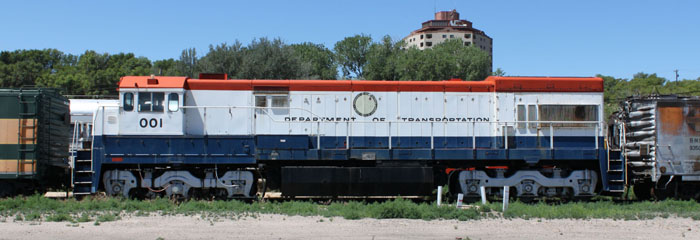
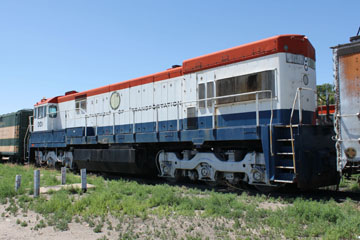

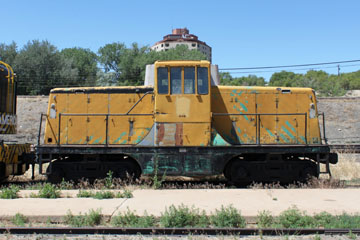
This GE 44-Ton Switcher is owned by the Canon City & Royal George Scenic Railway. It was built in 1947 for Colorado Fuel & Iron, later part of Oregon Steel Mills. CF&I's main steel mill was on the south side of Pueblo, and it was the city's main industry for much of its history.
#11 is 28' 4" long and weighs 90,000 lbs. With its two Caterpillar D 1700 diesel engines driving four GE 752AF traction motors, it delivered 12,400 lbs continuous tractive effort at 12 mph.
GE built three hundred and eighty-five of these units from 1940 to 1956, mainly for US and Canadian railroads, but thirty-seven for export to South America, Saudi Arabia, India and even Australia. Designed for light switching, they often replaced steam switchers in the US, as their 44 ton weight exempted them from having a two-person crew under agreements made with the railroad unions on new diesel power.
Many of the 44-Tonners remain in service or are preserved. You can see more examples on the Savannah Roundhouse Museum, Ogden Union Station, National Railroad Museum and Southeastern Railroad Museum pages of this website.

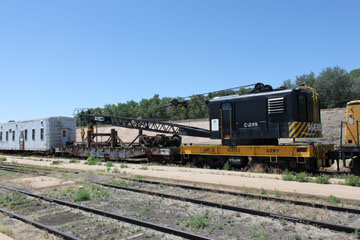
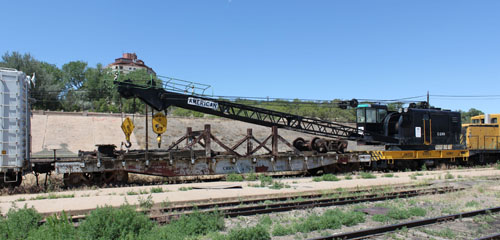
Built in 1951 by the American Hoist & Derrick Company in St. Paul, MN, for the US Army Transportation Corps, this 216,000 lb 840-DE crane is rated at 40 tons.
Under the brand American DiesElectric, American Hoist & Derrick produced cranes powered by diesel-electric engines of the kind used on locomotives. Direct diesel power was supplied to the deck and boom, while electric power was supplied to the crane's trucks. This allowed it to move itself along the track, as well as being able to switch cars on sidings.
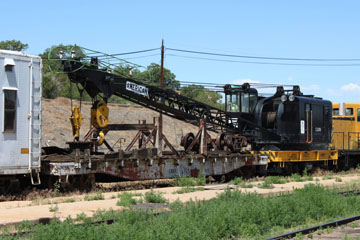
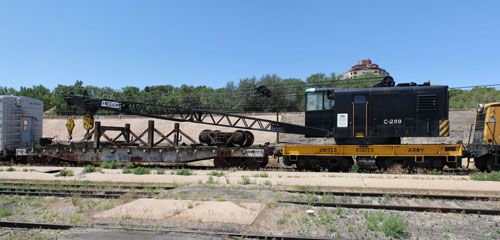
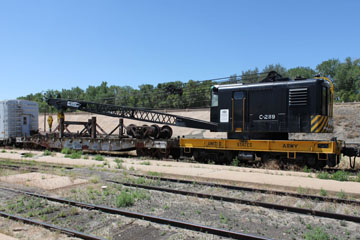
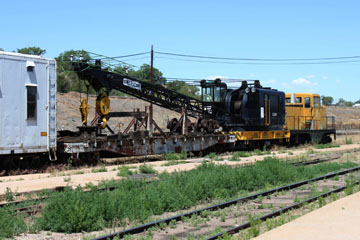
#C-289 is coupled to 40' CW Flat Car #A-1, BNSF Dining Car #951868, a box car converted for feeding track crews on-site and BNSF Tool Car #951859 . The museum still uses #C-289 on derailments and track work. It has a starting drawbar pull of 22,000 lbs reducing to 8,000 lbs at 4.1 mph or a maximum speed of 10.4 mph with no drawbar pull. The boom can be equipped with a hook, magnet or clamsheel bucket.
Ex US Army Transportation Corps DiesElectric crane 850-80 DE #C-271 is on the Southeastern Railroad Museum page of this website.


